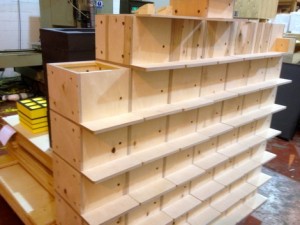Bumblebee queens where do they nest?
Bumblebee queens nest in all sorts of odd places! How do you find them? Observe, follow, observe, patience, patience, patience and a pinch of luck! This video shows a handful of the many strange locations I have found their nests.
Where do bumblebee queens select to make their nest sites?
From the literature I had available and my own findings, I have compiled the following list: Compost heaps, inside compost bins, old mice or vole nests, manure heaps, rockeries, bird boxes, thick undergrowth, grassy tussocks, leaf litter, under decking, under sheds, in ivy covered walls, in hedge banks, in grassy banks, in squirrel dreys, in holes in trees, in lofts, under roof eaves, in dry stones walls, inside house cavities, behind air bricks, field margins, field banks, under tree roots, hedgehogs’ nest, cavities in soil, under stones, under rubble, … and there’s more below!
Notice the dry grass blades as used by the B. pratorum bees for their nest. Where did they get this from, was it lying on the ground surface nearby, hence the queen chose that site and she, then her workers moved it bit by bit underground? It was near the surface and as the black soil absorbs heats, would warm the nest up.
I have one regret. A queen B. pascuorum was seen during the morning heading straight towards some brown moss-like vegetation as seen in the film found in an ivy clad fence. She obviously knew where she was going, not a typical nest seeking mode flight at all. I opened up the brown vegetation ball, heard her buzzing and there she was inside, snug as a bug in the middle. My opening of the massed vegetation made her abandon the nest which probably was in its very early stages. I checked the next few days hoping she would return. She did n’t.
One thing is certain, although nearby forage can be vital for the foundress queen, she will not be aware of what will be flowering in the summer months for her workers. She is not a plant expert that can recognise seedling flowers or plants! Thus a nest site must provide her with her immediate needs which she seeks out before starting her colony.
More unusual places have been found such as a rolled up carpet, a disused chair, under a lawnmower, under an upturned sink, in a coal heap, a disused robins nest, an old cushion, lagging on a water pipe, under upturned flower pots, the pocket of a fur coat and an old fishing net filled with wadding! The mind boggles. The one thing these sites had in common was they provided a warm, dry, dark and well insulated place to build a nest. No doubt you will find your own odd places too!
Oh yes and of course award winning bumblebee nest boxes!!
Read my case for the need of the right bee nest boxes in gardens.
Besides my own observations:
Refs.
Alford. D V. “Bumblebees” Northern Bee Books
Benton, T. (2006) “Bumblebees” Harper Collins, London
Goulson, D. ( 2010) “Bumblebees” Oxford University Press,
Prys-Jones, O E. & Corbet S A. (1987), “Bumblebees” University of Cambridge
Interested in Bumblebees? Bumblebee Conservation Trust
Intersted in Citizen Science and pollinators? (e.g. bees!) The Buzz Club


My word George, looks as though you’ve been busy with your nesting boxes. Sadly two queen bees found dead in the garden, don’t know why there are some pollinating shrubs in the garden, bit of a mystery. All my bee boxes are up. Havnt unfortunately any mason bee cocoons this year, but quite a number of leaf cutters. Hope I have some mason bees coming back to use the boxes,
Regards as always
Marian
Aw! why no mason cocoons? Did they die Marian?